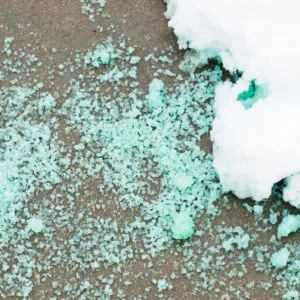We all know the drill after a snowstorm: apply rock salt to streets, walkways, and other well-traveled surfaces to prevent accidents. However, while this practice preserves our safety, it harms the landscaping. Follow these tips to prevent salt damage on the trees, shrubs, and plants in your yard this season.
Winter Woes for Trees and Shrubs
Salty spray from the road and salt-laden chemicals leaching into the soil affect water and nutrient intake in the root systems of trees and shrubs. Over time, the soil’s quality deteriorates as toxin levels increase. The results range from fewer leaves and blooms to premature leaf drop and twig dieback. Other symptoms include delayed development, early fall foliage color, burnt tips or edges on leaves, and brown needles on evergreens. These symptoms of salt damage differ from season to season and tree or plant variety, but are most visible in the spring. Several winters of salt damage often leads to death of weakened vegetation.
Tips to Help Prevent Salt Damage this Winter
Most damage occurs on vegetation near busy roads and heavily traveled pathways. If you are planting trees or shrubs, take care where you place more delicate species. Choose more salt-tolerant tree or plant varieties when adding greenery to your landscaping. Some trees that are more salt-tolerant include white and red oak, blue spruce, juniper, and paper birch. Avoid planting Douglas fir, dogwood, white pine, pin oak, and red maple too close to areas in need of salting.
To prevent salt damage to already existing vegetation, try using other materials that are less harmful to the environment. Alternative products like calcium magnesium acetate or magnesium chloride may cost more but less is required. Other gritty materials like sand, cinders, and kitty litter can be used in place of salt. Or try mixing these materials with salt to dilute the effects. Whatever you choose to use, apply less than the label states.
After icy weather, rinse away salt that has sprayed on shrubs or trees near roads and walkways. A good watering dilutes salt that has soaked into the soil. Or build barriers around more delicate trees and shrubs using fabric or burlap to help prevent salt damage.
Call Us in Any Season
Symptoms of winter salt damage are often similar to those of pest problems, disease, and drought. If you are uncertain of the cause of deteriorating plant life on your property, call in a landscape professional as soon as possible to help you identify and fix the problem. Contact Call Free Spray Lawn Care at 419-529-5296 with any questions on how to prevent salt damage.



Comments (0)
Thanks for your comment!
Thanks for your feedback! Your comments have been successfully submitted! Please note, all comments require admin approval prior to display.
Error submitting comment!
There is a problem with your comment, please see below and try again.